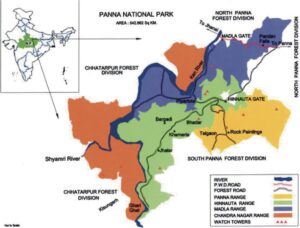Table of Contents
Panna Tiger Reserve
Panna Tiger Reserve is located in the Panna and Chhatarpur districts of Madhya Pradesh, India. It was declared a tiger reserve in 1994, and covers an area of approximately 542.67 square kilometers. The reserve is situated on the banks of the Ken River, and is home to a diverse range of flora and fauna. As of 2021, the reserve has a population of around 50 tigers, and efforts are being made to increase this number. Panna Tiger Reserve is also known for its scenic beauty, and visitors can enjoy a variety of activities such as jungle safaris, bird watching, and nature walks.
Read about: Tiger Reserves in India
Panna Tiger Reserve Landscape
Panna Tiger Reserve is located in the north-central region of India in the state of Madhya Pradesh. The topography of the reserve mainly consists of a mixture of plateaus, valleys, and gorges, with the terrain ranging from flat grasslands to rocky hills and deep ravines. The reserve is situated on the northern slopes of the Vindhya Mountain Range and is home to the Ken River, which flows through the reserve and is the lifeline of the region’s flora and fauna. The river also forms a natural boundary between the Panna and the adjoining Satpura Tiger Reserve. The reserve is characterized by a diverse landscape that provides an ideal habitat for the tiger and other wildlife.
Read about: Pilibhit Tiger Reserve
Panna Tiger Reserve Map

Panna Tiger Reserve Flora
Panna Tiger Reserve is a biodiversity hotspot known for its rich flora and fauna. The reserve is home to several rare and endangered plant species and has a unique ecosystem due to its location at the confluence of the Gangetic plain and Deccan plateau.
| Flora Category | Species Found | Unique Features |
| Trees | Tendu, Sal | Home to the oldest Sal tree in Asia |
| Shrubs | Aonla, Ber | Used for medicinal purposes by local tribes |
| Grasses | Khus, Dhaman | Used for making fragrant mats and baskets |
| Climbers | Bel, Piple | Provide natural habitat to several bird species |
| Herbs | Chirayta, Giloy | Used in traditional medicine for their healing properties |
Read about: Mudumalai Tiger Reserve
Panna Tiger Reserve Fauna
Panna Tiger Reserve is home to a diverse range of fauna. The reserve is spread across an area of 542.67 sq km and has a rugged terrain with hills, valleys, and plateaus. The reserve is known for its endangered species and conservation efforts.
| Fauna Category | Species Found | Unique Features |
| Mammals | Bengal tiger, Indian leopard, Indian wolf, sloth bear, sambar deer, chital, chinkara, wild boar, jackal, nilgai | Panna is known for its successful tiger reintroduction program after facing severe decline in the past |
| Birds | White-naped vulture, Red-headed vulture, Indian vulture, Greater spotted eagle, Indian pitta, Paradise flycatcher, Painted sandgrouse | Panna is a haven for birdwatchers, especially during winter months |
| Reptiles | Mugger crocodile, Indian python, Indian cobra, Russell’s viper, common krait | The reserve has a healthy population of mugger crocodiles in its water bodies |
| Insects | Butterfly species like blue mormon, common banded peacock, great eggfly, tailed jay | The reserve is home to a variety of insect species, making it a great place for nature enthusiasts |
Read about: Sariska Tiger Reserve
Panna Tiger Reserve Tourism
Panna Tiger Reserve is a popular tourist destination in Madhya Pradesh, India, known for its rich wildlife and natural beauty. The reserve offers a range of activities for tourists, including jungle safaris, bird watching, and nature walks. The best time to visit is from October to June when the weather is pleasant, and wildlife sightings are more frequent.
To reach Panna Tiger Reserve, one can take a flight to Khajuraho Airport or a train to Khajuraho Railway Station, which is located about 40 km from the reserve. From there, one can hire a taxi or take a bus to the reserve. Apart from the wildlife sanctuary, other nearby tourist attractions include the famous Khajuraho temples, the Rajgarh Palace, and the Pandav Falls.
Read about: Periyar Tiger Reserve
Panna Tiger Reserve UPSC
The topic of Panna Tiger Reserve is important for the UPSC exam as it falls under the Environment and Ecology section of the UPSC Syllabus. The exam often includes questions related to wildlife conservation efforts and the significance of protected areas like Panna Tiger Reserve. Additionally, candidates must also be aware of the economic and social aspects of wildlife conservation. To gain a better understanding of effective UPSC exam preparation, one can explore the official StudyIQ UPSC Online Coaching website. Additionally, the website offers UPSC Mock Test for Prelims 2023, providing an opportunity to evaluate your level of preparation for the exam.
Read about: Parambikulam Tiger Reserve


 Nilgiri Biosphere Reserve, Map, Climate,...
Nilgiri Biosphere Reserve, Map, Climate,...
 Repo Rate and Reverse Repo Rate, Impact ...
Repo Rate and Reverse Repo Rate, Impact ...
 Foreign Contribution Regulation Act (FCR...
Foreign Contribution Regulation Act (FCR...





















